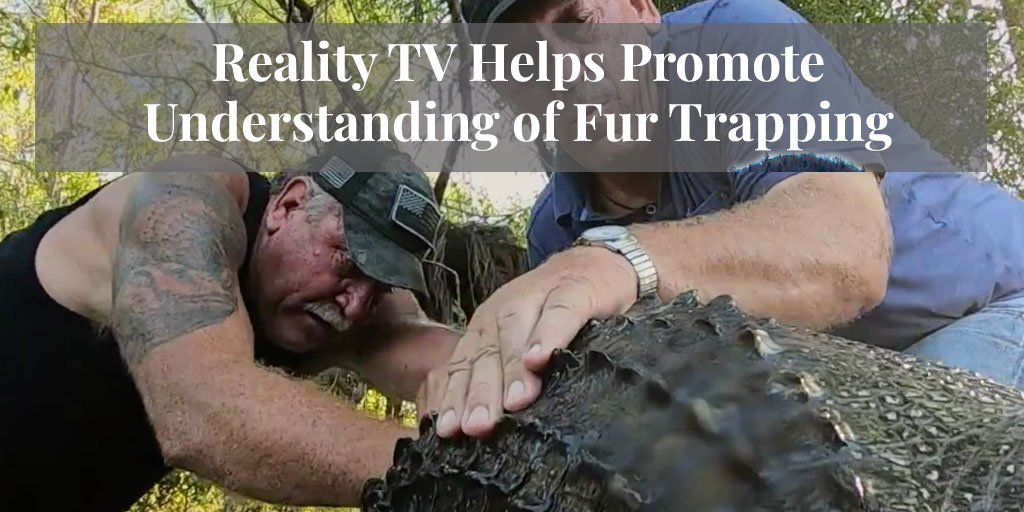The current crop of reality TV shows suggests that not only are many North Americans interested in living closer to…
Read More

The current crop of reality TV shows suggests that not only are many North Americans interested in living closer to nature, they actually crave it. This should bode well for the future of all outdoor activities that involve the taking of animal life, including fur trapping.
This is not a new idea, at least not for me. A decade ago I wrote a piece entitled "Mountain men wannabes: Allies of the fur trade", asking whether we were doing enough to tap into a large base of reality TV fans interested in getting their hands dirty in the great outdoors.
What I wasn't sure of was how many other people were thinking the same thing.
And then I read a July 29 article entitled "Interest in trapping doubles in five years". Town and Country Today had interviewed Alberta Trappers Association president Bill Abercrombie, and one of his comments caught my eye:
"I’d say definitely there is some increased popularity and interest from reality TV shows," said Abercrombie, "but most of all I think because trappers have many skills based on self-sufficiency, sustainable living on the land and bushcraft knowledge."
Agreed, reality TV shows don't deserve all the credit, or maybe even a large part of it. Above all, people's interest in "sustainable living on the land" is growing because of our hugely improved awareness of issues like climate change, pollution, and habitat loss.
SEE ALSO: As society’s grasp of sustainability improves, is fur making a comeback? Truth About Fur.
Still, reality TV is playing a role in all this, whether it's because producers are setting trends or pandering to those that already exist. It's also vindicating for me to hear someone else actually say it!
Swamp People
A major exploiter of this genre is the History Channel, though there are several others.
For an impressive 15 seasons, History's Swamp People has been shooting Louisiana alligators in the head, while dispensing tidbits of advice on family values, protecting communities, and occasionally wildlife management. The show is also now on its third spinoff series, Swamp People: Serpent Invasion, in which cast members bag giant Burmese pythons in the Everglades. A lot of the action is surely staged, but the conservation message about invasive pythons is very real.
Then there's Mountain Men, now in its 12th season, that teaches viewers to chase mountain lions with dogs, haul logs, roast squirrels, and grow shaggy beards.
And for 11 seasons, the survival series Alone has taught us how to fish with thorns, trap rabbits, shoot grouse with a homemade bow and arrow, and build an earth shelter.
Sanitised Killing

An important part of these shows is that they don't – can't – dodge the fact that killing animals is an intrinsic part of whatever lifestyle they are promoting.
Sure, the actual killing process is sanitised (i.e., not shown), but it takes little imagination to guess what happens off-camera.
Thus in Swamp People, we never actually see a gator take a bullet in the skull, but we do see a rifle muzzle being discharged while someone yells "Choot it!"
In Mountain Men and Alone, we know the wounded rabbit or grouse had its neck wrung, though we are spared the sight.
Serpent Invasion is more ambiguous. Pythons are caught live and by hand, then thrown in sacks, so sensitive viewers can kid themselves they end up in pet stores or zoos. But local law says they are actually dispatched on site by a trained professional, usually with a captive bolt pistol.
History Channel even gives us scenes of butchery, albeit minus the blood and in an unlikely setting. On its hugely popular reality show Forged in Fire, newly crafted blades are often tested for sharpness and strength on bled-out pig carcasses, salmon and ram skulls.
PETA and Friends Silent
Against this backdrop of animal slaughter and butchery, the silence of animal rights groups has been remarkable.
It's tempting to trot out an old argument that since most people hate crocodilians and snakes (and spiders) anyway, campaigning for their rights would be a lost cause. But that doesn't quite hold water given that PETA et al. are now fighting hard to ban "exotic skins" from croc and python farms.
Another old argument that no longer works is that you don't protest against leather at a Hell's Angel rally. Sure, gator hunters tend to be large and survivalists are ridiculously healthy, but in this age of remote protesting afforded by the Internet, the chances of them gutting and skewering you are zero.
My explanation is far more positive.
Commercial TV executives, and the bodies that regulate what programs can show, are all about giving us what we want – with obvious exceptions. And that means that a group of people sat down somewhere and discussed topics like:
• Is it ok to show alligators being shot in the head?
• Is it ok to show rabbits being trapped or grouse being shot with an arrow?
• Is it ok to show pig carcasses being cut to pieces?
Obviously regulators approved all these, with conditions, suggesting that showing such scenes has been judged beneficial – educational even – to society as a whole.
If my logic is sound, it tells me two things.
First of all, it tells me that the majority of North Americans accept the killing of animals as part and parcel of living close to nature.
And second, it underscores that the targeting by animal rights groups of wild fur trappers is arbitrary and therefore unjust. We need to stress this in our public relations.
If the North American public are ready for scenes of gators being shot in the head, rabbits being trapped, and pig carcasses being cut to ribbons, it's also ready for scenes of fur trappers at work.
And before you say it, many furbearers also make extremely good eating.







